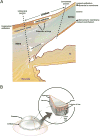Limbal stem cells: identity, developmental origin, and therapeutic potential
- PMID: 29105366
- PMCID: PMC5814333
- DOI: 10.1002/wdev.303
Limbal stem cells: identity, developmental origin, and therapeutic potential
Abstract
The cornea is our window to the world and our vision is critically dependent on corneal clarity and integrity. Its epithelium represents one of the most rapidly regenerating mammalian tissues, undergoing full-turnover over the course of approximately 1-2 weeks. This robust and efficient regenerative capacity is dependent on the function of stem cells residing in the limbus, a structure marking the border between the cornea and the conjunctiva. Limbal stem cells (LSC) represent a quiescent cell population with proliferative capacity residing in the basal epithelial layer of the limbus within a cellular niche. In addition to LSC, this niche consists of various cell populations such as limbal stromal fibroblasts, melanocytes and immune cells as well as a basement membrane, all of which are essential for LSC maintenance and LSC-driven regeneration. The LSC niche's components are of diverse developmental origin, a fact that had, until recently, prevented precise identification of molecularly defined LSC. The recent success in prospective LSC isolation based on ABCB5 expression and the capacity of this LSC population for long-term corneal restoration following transplantation in preclinical in vivo models of LSC deficiency underline the considerable potential of pure LSC formulations for clinical therapy. Additional studies, including genetic lineage tracing of the developmental origin of LSC will further improve our understanding of this critical cell population and its niche, with important implications for regenerative medicine. WIREs Dev Biol 2018, 7:e303. doi: 10.1002/wdev.303 This article is categorized under: Adult Stem Cells, Tissue Renewal, and Regeneration > Stem Cells and Disease Adult Stem Cells, Tissue Renewal, and Regeneration > Tissue Stem Cells and Niches Adult Stem Cells, Tissue Renewal, and Regeneration > Regeneration.
© 2017 Wiley Periodicals, Inc.
Figures





References
-
- Davanger M, Evensen A. Role of the pericorneal papillary structure in renewal of corneal epithelium. Nature. 1971;229(5286):560–1. - PubMed
-
- Tseng SC. Concept and application of limbal stem cells. Eye (Lond) 1989;3(Pt 2):141–57. - PubMed
-
- Lehrer MS, Sun TT, Lavker RM. Strategies of epithelial repair: modulation of stem cell and transit amplifying cell proliferation. J Cell Sci. 1998;111(Pt 19):2867–75. - PubMed
-
- Cotsarelis G, Cheng SZ, Dong G, Sun TT, Lavker RM. Existence of slow-cycling limbal epithelial basal cells that can be preferentially stimulated to proliferate: implications on epithelial stem cells. Cell. 1989;57(2):201–9. - PubMed
Publication types
MeSH terms
Substances
Grants and funding
LinkOut - more resources
Full Text Sources
Other Literature Sources
Medical

